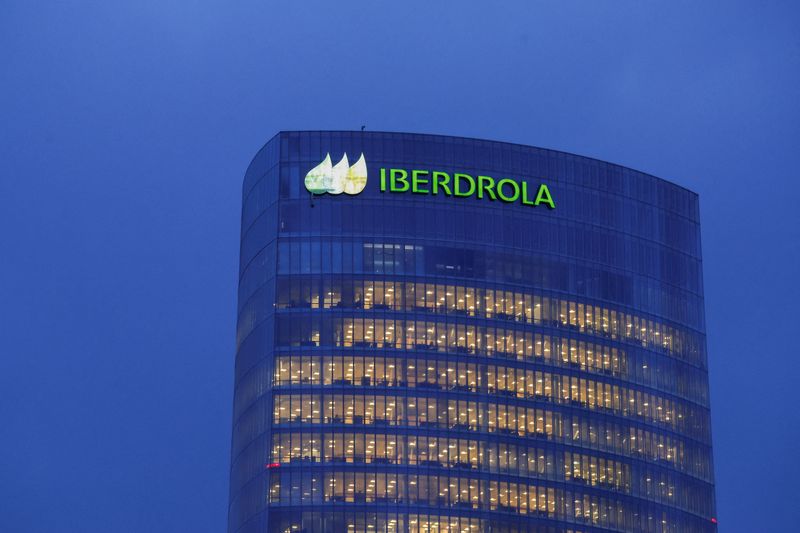By Pietro Lombardi and Nina Chestney
MADRID/LONDON (Reuters) - Spain's Iberdrola (BME:IBE) is set to tell investors on Thursday it will focus spending over the next three years on expanding and upgrading grids, as it builds on a strategy that made it Europe's top utility by market value.
Iberdrola has weathered an energy crisis and rising costs of renewable projects better than many continental peers and has cash to spare from the relatively steady income grids can provide.
Analysts say they expect it to maintain annual investments in the double-digit billion euros, concentrating on networks.
The Spanish utility boosted its spending capacity when in January it scrapped the planned purchase of U.S. energy firm PNM Resources, for which it had allowed some $12 billion. It also has $6 billion from the sale of gas assets in Mexico.
Earlier this month, it offered $2.5 billion to buy the remaining 18.4% in its U.S. subsidiary Avangrid that it does not yet hold, with a goal to "increase exposure to the networks business" in the country.
The obvious question ahead of Thursday's strategy update meeting is what does it plan for the rest of its cash.
Executive Chairman Ignacio Sanchez Galan has said U.S. power grids still promise the best returns, followed by Britain and Brazil.
Iberdrola's Spanish home market offers less scope, in part because of legal limits on how much energy companies can invest in power networks.
Brazil, Britain and the United States are less restrictive and the demand implications of Brazil's growing population have also tempted peers.
"I would like to tell you something clearly," Sanchez Galan told analysts in February while presenting financial results. "In this moment, in networks we have huge opportunities."
He did not give details, although a company source, speaking on condition of anonymity, gave a range of 6.5%-7.5% for the return of grid investment.
For renewables, the source would not give specific figures, but said the company was taking a cautious approach and acceptable returns on renewable projects have to cover the cost of financing them plus 150-200 basis points.
The sector has been hit by high interest rates, rising debt costs and doubts about projects' profitability tied to depressed wholesale electricity prices. They have fallen sharply after reaching records in 2022 as a result of the disruption caused by Russia's invasion of Ukraine.
QUICK TO GRASP PREDICTABLE MONEY
Before the current uncertainty, Iberdrola's grasp of the potential of the emerging clean energy sector helped to make it the biggest electric utility in Europe two years ago. Its market capitalisation is around 71 billion euros, according to LSEG data, placing it among the largest utilities globally.
Since the start of this decade, it has invested around 41 billion euros, which helped it to amass approximately 42 gigawatts of solar, wind and hydro capacity and increase the value of its network assets to more than 42 billion euros.
But Iberdrola acted to limit its exposure ahead of its peers, announcing in 2022 that it would shift its investment focus to power grids, which account for about half of its core earnings and have provided it with a relatively stable cash flow.
Late last year, Italy's Enel (BIT:ENEI) said it too would become more cautious about renewable projects.
"Iberdrola seems to have realised before Enel that you could make more predictable money in networks than in renewables," Gonzalo Sanchez-Bordona, analyst at UBS, said.
"In renewables, you have to compete with someone for every single project. Grids are natural monopolies and, once you control these assets, you need to convince a regulator to invest more but then that's it: you don't have to compete with anyone."
BILLIONS OF GRID INVESTMENT NEEDED
While active in the U.S. offshore wind sector, the inflation and supply chain issues that increased project costs have affected Iberdrola less than its peers.
It ended power purchase agreements for two of its U.S. offshore wind projects last year after rises in project capex made them uneconomic. The decision avoided big write-offs down the road, Sanchez Galan said.
Iberdrola has sought to expand in the U.S. to take advantage of its green subsidies. Under its 2023-2025 plan, the country was expected to receive 47% of the company's global investments, mostly for grids but also for renewable energy production.
This included the PNM deal, which was abandoned because of regulatory issues. Higher interest rates than when the deal was announced also raised questions about the price it was paying.
Analysts do not expect acquisitions on the scale of PNM but some smaller deals are possible, they said.
Late last year, Reuters reported Iberdrola was considering a bid for British power network operator Electricity North West.
The company will focus on adapting decades-old grids from the traditional model of large, fossil fuel power plants to wind and solar power generation and building new ones where needed, they said.
The European Commission estimates that Europe will need to invest 584 billion euros ($637 billion) to upgrade its power grids this decade and improve storage.
Iberdrola is relatively well-placed in that it has abundant reserves of hydropower, which can equate to more effective storage than batteries.

The biggest worry for investors could be who next as much as what next.
"One thing that people are becoming increasingly worried about Iberdrola is the fact that this company has been run by the same management for the past 20 years, so there is a bit of a question mark as to what will happen when Mr. Sanchez Galan's gone," Sanchez-Bordona of UBS said.